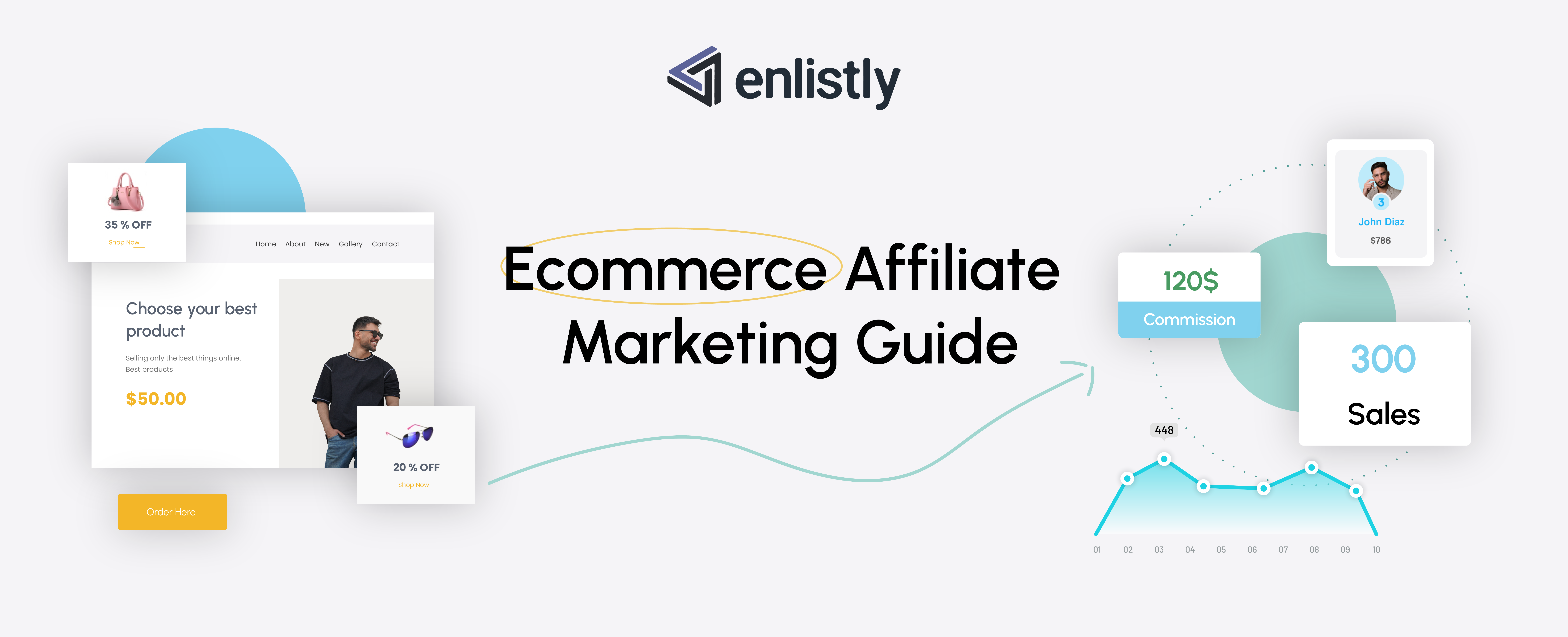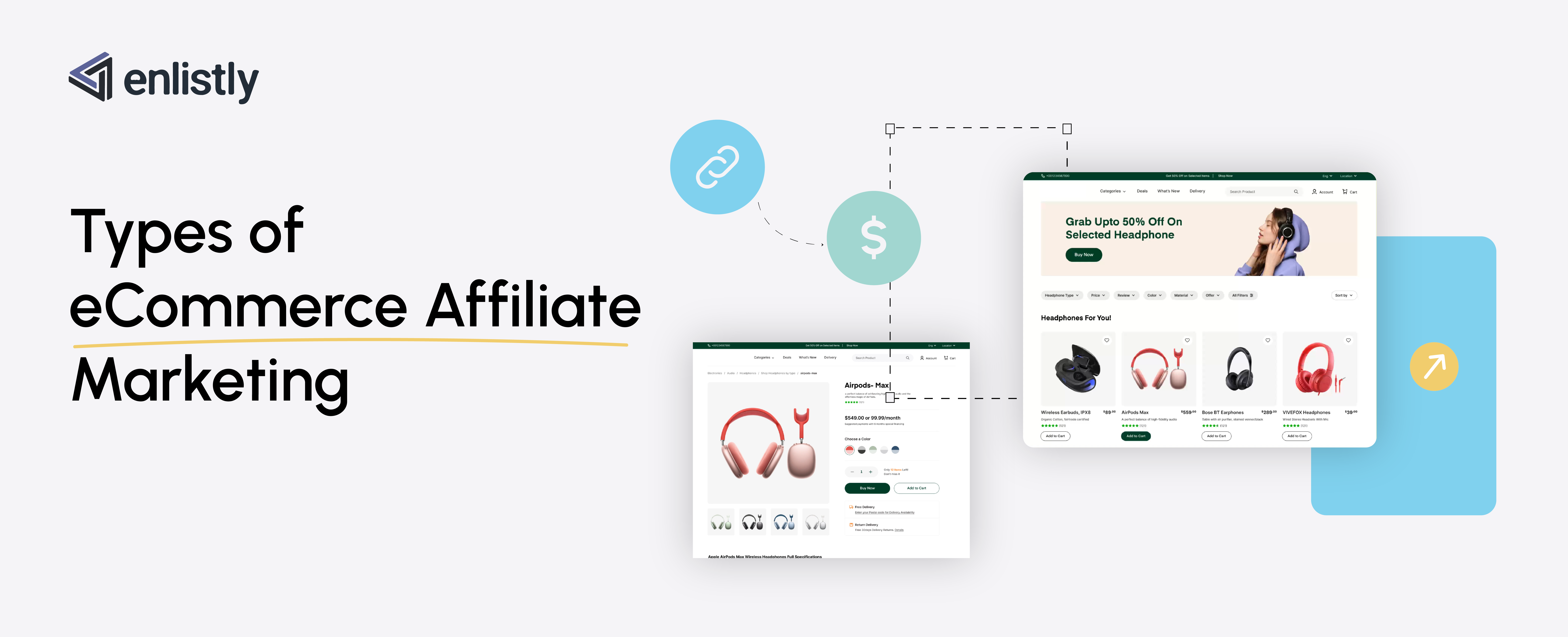Complete Guide to Understanding Ecommerce Affiliate Marketing

Learn all about eCommerce affiliate marketing.
In this Information Age, the complete dynamics of eCommerce business are changing. People are consuming online content like never before. Even marketing is not the same. It has evolved from plain-vanilla ad prints to highly-personalized forms. And eCommerce affiliate marketing is one of the newer strategies in this series of marketing evolution.
Affiliate marketing is like having a team of hundreds or even thousands of sales executives promoting your products. According to an Inc. report, affiliate marketing is the best customer acquisition channel for almost 40% of US merchants.
Pretty sweet, right?
It helps eCommerce businesses to stand out from their competitors. Firstly, you give your customers an opportunity to earn by joining your affiliate program. And then, they promote your products which not just bring sales but also act as social proof for your business. When a customer converts, you get a sale, and they get a commission. It’s a win-win!
But even after being so effective at driving sales, eCommerce businesses often overlook affiliate marketing. This Shopify affiliate marketing guide will cover everything you need to understand how it works and how you can set it up for your eCommerce store. Let’s dive right in.
What Is eCommerce Affiliate Marketing?
An eCommerce affiliate marketing program acts as an agreement between your business and affiliates like small businesses, bloggers, or influencers to share your products with their audience. And when someone buys a product using the affiliate link, the affiliates get a commission.
It’s one of the most uncomplicated and low-risk marketing strategies for businesses to open an additional stream of revenue. Customers like affiliate programs because they get good product recommendations from the bloggers/influencers they trust. It saves their time and money, and for you, it improves the customers’ satisfaction level.
The more affiliates you have to promote your products, the more potential customers will notice you. Basically, your affiliates are an extended part of your sales and marketing team as they help you increase your customer base and generate more revenue.
This is one of the best strategies for small eCommerce businesses because it doesn’t require the business owners to pay unless a conversion is made. Moreover, affiliate marketing increases the pace of your growth because of its vast and influential reach.
How Does eCommerce Affiliate Marketing Work?
Affiliate marketing begins when an eCommerce business launches an affiliate program. Once the program is set up, there’s a typical process for the affiliate to signup and begin driving sales for the brand’s products.
The functioning of affiliate marketing can be summarized in the following four steps.
1. eCommerce Business Sets up an Affiliate Program
For driving more sales, the first step, obviously, has to come from you. You need to set up an eCommerce affiliate program, which you can easily do using Shopify apps like Enlistly. It’s a no-code and full-featured affiliate management platform that allows you to track orders in real time.
When you set up an affiliate program, both you and your affiliate get a dashboard to track the conversions and commissions. Later in the blog, we’ll also discuss some things that you should keep in mind while setting up an affiliate program.
2. Affiliates Get Their Unique Link to Track Referrals
Now when the dashboards are ready for both parties, affiliates can automatically generate their unique link for different products. This unique link is trackable, meaning you can identify who was responsible for which sale.
Moreover, when the audience clicks on the link, a cookie gets stored in their browser. If you have specified an expiry time for the cookie, the affiliate will still get an incentive even if the customers delay the purchase. Giving these valuable features to your affiliates makes your program worthy for them.
3. Audience Clicks and Reaches the Product Page
Once affiliates have their links, they can insert them on their blogs, social media, or other channels. When the audience reads/views the content and clicks on the link to buy the product, they’ll be redirected to your product page.
4. Conversions Are Tracked and Affiliates Get a Commission
After landing on the product page, if customers make a purchase, it’ll be added to the affiliate’s dashboard. Now, how often you transfer the commission depends on your affiliate program settings. You can offer weekly/monthly settlements or allow your affiliates to choose the settlement period of their choice.
Affiliate Marketing Statistics
Here are some stats that show how effective an affiliate eCommerce program can be for your store.
Consistent growth in global affiliate marketing spend
Global affiliate marketing spend is increasing consistently for the past ten years. It is almost $13 billion in 2022. And looking at the trajectory, it is expected to reach $15.7 billion in 2024.
Affiliate marketing is the #2 marketing strategy that eCommerce brands use
After Google AdSense, it’s affiliate marketing that generates the most revenue for online stores. It’s followed by display advertising, brand partnership, paid product reviews, etc. But the fact that it ranks just after Google AdSense makes it worth giving a shot.
Interest in affiliate marketing is increasing at a rapid pace
Over the past few years, more and more brands have been showing interest in affiliate marketing. Google Trends shows that from the year 2017 to 2020, the interest in eCommerce affiliate marketing doubled. In 2021, the numbers again increased two times. The interest has now finally settled at 300% higher than it was five years ago.
Affiliate marketing is one of the best customer acquisition channels
40% of US merchants cited affiliate programs as their top customer acquisition channel. This stat, published by Backlinko, shows how effective affiliate marketing is when it comes to bringing more customers to your store.
Affiliate marketing meets the revenue expectations of 73% of eCommerce brands
The majority of eCommerce brands are more than happy with the result they’ve got from affiliate marketing strategy. This strategy is one of a kind, where the chances of getting success are quite high.
More than 80% of brands reported that affiliate marketing boosted their annual revenue by 20%
A report by Rakuten Advertising says that more than 80% of eCommerce brands believe that affiliate marketing is critical for them to thrive, as they’ve witnessed an average of 20% growth in annual revenue.
Fashion is the most popular niche for affiliate marketing
According to a report by AM Navigator, fashion is the most popular niche for affiliate marketing, followed by Sports & Outdoors, Health/Wellness & Beauty, Travel, and Home & Garden.
Affiliate marketers prefer computers and the electronic sector
Now fashion might be the most popular niche, but more than 40% of affiliate marketers prefer promoting products in the tech industry because of high commission rates. Irrespective of the industry, affiliate marketing can generate a good return on a very low investment.
Benefits of eCommerce Affiliate Marketing
For eCommerce brands, the benefits of having an affiliate marketing program are huge. This marketing strategy makes it easy for you to reach more customers and let them know who you are and what you sell. Let’s go through some benefits that make an eCommerce affiliate marketing program compelling for online stores.
Easy to Start
The reason why affiliate marketing is so attractive for eCommerce businesses is that they can get started with it quite easily and without having to invest much. With tools like Enlistly, setting up an affiliate dashboard becomes a two-minute task. And you don’t even have to be a tech expert to set it up.
Moreover, you don’t even need to have a deep pocket like established competitor brands. Even for small businesses, affiliate marketing helps generate more revenue per dollar spent on marketing. You don’t have to pay affiliates unless they are bringing sales to you, which makes it a low-risk option for you.
Get a High Return on Investment
With affiliate marketing, you don’t have to rely on advertising teams and don’t even have to buy ad space. Your affiliates will be creating marketing content to drive sales for your eCommerce store.
And because the setup is performance-based, you don’t need to pay for impressions or potential customers. You’re only paying for the sales you get, which gives you a higher ROI.
Get More Reach in No Time
The ability to expand the reach is one of the biggest benefits of an affiliate marketing strategy. It helps you reach customers who have no idea about the existence of your business.
For a new eCommerce store, it takes time to build its own audience. But when they tap into Shopify affiliate marketing, they enable themselves to leverage the active audience of their affiliates. And if the audience of your affiliates aligns with your business, they become a valuable traffic source.
Control on Products You Want to Promote
When you’re creating affiliate offers, you have complete control on hand. It’s you who decides if you want to promote every product or just a select few.
Some products have a low-profit margin, and you might not get enough profit after paying the commission. Therefore, it’s a good idea to allow your affiliates to promote only high-margin products. You can also let them promote products that are stuck in your inventory, improving your sell-through rate.
Boost SEO of Your Store
Your affiliates will be creating content to promote your product. And to sell the product, they’ll insert backlinks which are crucial for page ranking. It’ll help boost the SEO.
The best part is that you don’t have to pay for these high-quality backlinks. The more affiliates you have, the more backlinks you get and the higher your product page ranks.
Helps Build Social Proof
When you partner with trusted affiliates, their content about your products can create a good reputation for your brand. It’s because they already trust the affiliates’ content. So in the future, when customers will read the product reviews, they’ll feel more confident purchasing it from you.
Easy Tracking and Scalability
Using an affiliate management tool, you can easily track impressions, clicks, leads, sales, commissions, revenue drivers, etc., in the dashboard. Moreover, affiliate marketing is highly-scalable as you can integrate it with your other marketing efforts.
Brands Using eCommerce Affiliate Marketing
We have rounded five of the best eCommerce affiliate marketing examples to help you design an effective affiliate marketing program for your store. You might not be as big a brand as mentioned below, but these brands have the best eCommerce affiliate programs to take inspiration from.
Amazon – Amazon Associates Program
Amazon boasts the largest affiliate program in the world. Over time, its affiliate program has gone through multiple evolutions. The Amazon associate program is easy and free to join for affiliates.
Amazon associates can select any of the listed products and can earn up to 10% commission on them. However, Amazon offers an 8% commission for furniture because these are high-value items, so the commission amount is pretty high too.
Skillshare – Online Learning Platform
Skillshare is an online platform providing courses on various topics like photography, art, coding, management, etc. Their affiliate program is top-rated among educational Youtubers, who get a commission for free trial signups and paid subscriptions.
Affiliates receive their payout timely after 30 days, which keeps them happy. Moreover, affiliate links of Skillshare have a 30-day cookie life. Meaning, that affiliates will get a commission on purchases up to 30 days from when the customer has first clicked on the link.
Missguided – Affiliate Program and Customer Referral Program
Missguided is a fashion eCommerce store for women, selling swimwear, tops, denim, shoes, and dresses. They first launched a referral program where on referring a friend, customers could earn up to 30% commission on the purchase.
Later, they came up with an affiliate program offering a 6% commission per sale. For affiliates with a great following, this was a great way of monetizing their audience. One common thing that made this affiliate program successful was timely payments and additional discounts for affiliates.
Keep the affiliates happy, and they’ll keep the sales coming!
Spocket – Purchase and Dropship
Spocket is an online purchase and dropship store for entrepreneurs and wholesalers across Europe and US. Entrepreneurs can easily reach out to stores to buy samples to easily describe the features to their clients.
Its affiliate program follows a tiered payment structure where affiliates can earn up to 30% commission based on their performance. Affiliates keep earning commission from the buyers who keep renewing their subscriptions. Affiliates can easily track their commissions and sales through their custom dashboards.
Wayfair – Furniture
Wayfair offers over 7 million products across all major home categories. And out of these 7 million products, 2 million are open for affiliate marketing. It creates more choices and opportunities for affiliates, giving them the freedom to select what they want to promote.
Anyone with a website or a blog is eligible for Wayfair’s affiliate program. They offer a generous 7% commission on sales with a cookie life of 7 days.
What to Consider Before Building an Affiliate Program
Now that we’ve seen how beneficial affiliate marketing can be for your eCommerce store, let’s look at some key business aspects you need to consider before launching it.
Do Competitor Research
The first thing you need to do is identify what’s working for your competitors’ affiliate programs. You can create a spreadsheet for them and keep track of their affiliate networks, how much commission they offer, what’s their cost-per-action, etc.
You can even join their affiliate marketing program to get in-depth details about it. Moreover, you’ll also get access to their affiliate email strategy, the bonuses and incentives they offer, and much more.
When you have access to this data, you can match their commission strategy to target their affiliate networks. However, if you’re low on budget, you can reach out to affiliates that do not have a relationship with your competitors.
Know Objectives and KPIs
What you want to gain from an affiliate marketing program determines who your affiliates should be and how much you should pay them. The object can be to increase sales, boost site traffic, increase your average order value, etc.
When you are clear with your objectives, make a list of KPIs that’ll help you avoid faltering from the growth track. Here are some common KPIs:
- Click Traffic
- Gross Orders
- Net Orders
- Commission
- Top Affiliates and Their Share of Total Sales
- Total Affiliates
- Percentage of Active Affiliates
- ARPU (Average Revenue per Order)
- EPC (Earnings per 100 Clicks)
Determine Affiliate Commission Percentage
To create an affiliate program that keeps your affiliates happy, you must have a well-defined commission percentage structure. There should not be any hidden deduction. Otherwise, no affiliate would want to promote your product.
Here are some factors that you need to know for determining the commission:
- Cost per Acquisition (CPA)
- Average Order Value (AOV)
- Cost of Goods Sold (COGS)
- Gross Margin
The most important factor that’ll help you offer higher payouts to your affiliates is the Customer Retention Rate.
Check Your Customer Retention Rate
How many customers keep purchasing from you after an initial purchase is what helps you determine how high you can go.
If you have a low customer retention rate, you can’t afford to pay a good percentage of your profits. Because a low retention rate means you’ll have to keep acquiring new customers. And if you’re not generating good profits from acquired customers, your affiliate program will fail in the long run.
However, if your customer retention rate is high, you know the customers will return and purchase from you again. So, for the first purchase, you can offer a generous commission to the affiliates.
How to Get Started With Affiliate Marketing
Here’s a step-by-step plan to set up an affiliate marketing program for your eCommerce store.
Decide What You Want to Start Promoting
Because you’ll have to give some percentage of your profits to your customers, it’s essential to determine what products you should promote.
The most suitable products for affiliate marketing are the ones with higher profit margins. You’ll have room to offer discounts to customers, and you’ll still earn a decent profit.
Get an Affiliate Management System
When you’ve decided on the products you want to promote, you need a system to manage your affiliates. For this, you can go for an affiliate management system that handles all the technical aspects of your affiliate program.
Enlistly is one of the best Shopify affiliate marketing apps. It takes care of all your tasks, from recruiting and generating unique affiliate links to tracking their performance and payouts.
Attract Affiliates
Once you have the affiliate management system in place, create a page on your website where affiliates can sign up for the program. You can then promote your newly launched program across social media channels to attract more affiliates.
For affiliates who apply for the program, decide if they are a good fit for your affiliate program based on their reach, niche, and experience. Using some SEO tools, you can check the performance of their previous affiliate posts.
You should be good to go if all these factors combined match your expectations.
Conduct Ongoing Reviews
Once you’ve onboarded the affiliates, you should conduct regular reviews to check how affiliates perform for you.
Here are some metrics that you need to keep reviewing:
- Which affiliate is bringing maximum sales?
- How much traffic is coming via affiliate links?
- What percentage of affiliate traffic is converting?
- How much do you pay for the affiliate program every month?
You can collect all the above-mentioned data from your affiliate management tool. And using this data, you can analyze how affiliate marketing works for your business.
Start Your Affiliate Program Today
Affiliate marketing has the potential to increase sales for your eCommerce significantly in a very cost-effective way. You’ll not just be leveraging the websites of your affiliates for direct sale increase, but it will also improve your search ranking.
In the next blog, we’ll cover different types of affiliate marketing for eCommerce businesses.
If you’re ready to set up affiliate marketing for your eCommerce store, you should start by getting an affiliate management tool.
FAQS for Affiliate Programs
What Is eCommerce Affiliate Marketing?
It’s just like any other affiliate marketing, but here the focus is on promoting eCommerce products. Here an eCommerce store launches its affiliate program and issues unique links for its affiliates. When customers purchase a product via that link, the affiliates earn a commission.
Does an Affiliate Marketing Strategy Work for Every Ecommerce Business?
Yes, it does. However, how effective it is for your eCommerce store depends entirely on what you sell. If the profit margins are huge, it’ll be more effective than those with low-profit margins.
Is Affiliate Marketing Cost-Effective?
Affiliate marketing is one of the most cost-effective ways to increase the sales of your eCommerce store. Here you don’t have to pay any upfront cost, and there is no ad spend either. All you have to do is offer commissions for every sale you get via affiliate links. It’s also one of the low-risk ways of marketing.




